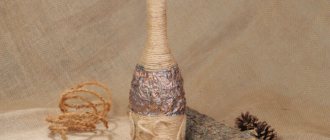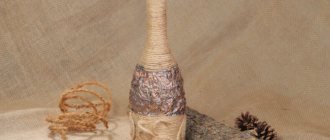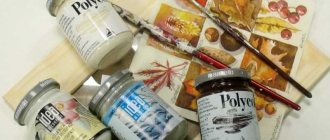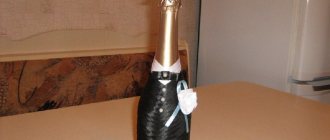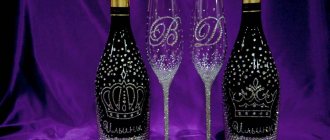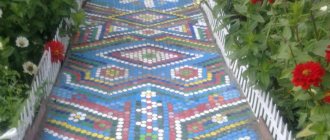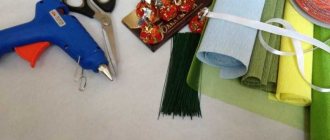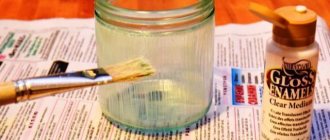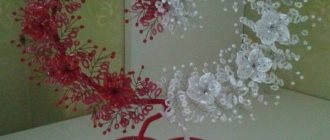Types of decoupage
This technique has its roots in ancient China, where artisans decorated screens, ceramic vases and even the facades of some buildings with designs! But after the Great Silk Road was laid in the Middle Ages, the decoupage technique migrated to Europe and French craftsmen began to decorate furniture, dishes, and tapestries with paper ornaments. Despite the fact that decoupage is a type of decorative and applied art in China, it has a French name, and translated means “to cut out.” This is what it's all about, cutting out the paper and gluing it to the surface. But modern craftswomen don’t limit themselves to this; they tie unusual scarves and ribbons on the decorated bottles, glue rhinestones and beads. And a layer of paint is also applied on top of the decorations!
At your service there is always a master class in the company of a master or an online version of the work process.
It is not at all surprising that decoupage has undergone a lot of changes and acquired many types throughout its centuries-old existence. Of these, five main ones can be distinguished.
- Decopatch. This method of decorating a product is reminiscent of sewing a patchwork quilt. Indeed, the decor is created from individual pieces of paper or napkins. They can be combined with each other thanks to a common theme, colors and texture, or they can be completely opposite to each other. There are even special decopatch kits on the market, which are combined in style, meaning and colors; they will help the novice craftsman in making a bottle that will please the eye, but no one will forbid you to create such kits yourself!
Design ideas can be seen on forums where needlewomen share their achievements.
- Direct or classic decoupage. This type of decoupage is suitable for those who are just trying themselves in a new type of creativity. The technology for making the work is very simple and will be understandable to every master; even a child can handle it. The image applied to napkins, photo paper or rice paper is carefully cut out and glued to a previously prepared surface. You need to work very carefully so that the finished work is not damaged by folds, bubbles or tears. There are many ways to paste a picture, but three main ones can be distinguished: using a file, a fan-shaped brush, or an iron.
Each of the methods is good in its own way, but not everyone is suitable for applying an ornament to a bottle.
- Reverse decoupage is the opposite of classic decoupage. Suitable for decorating objects made of transparent thin glass. In this case, the drawing is applied to the inside of the object and all steps for applying it are performed in the reverse order.
It is worth remembering that a bottle made using reverse decoupage is not suitable for storing liquids.
- Artistic or, as it is also called, smoky decoupage. This type of decoupage is suitable for those needlewomen who want to create the effect of a painting or fresco on the product they are decorating. This effect can be achieved due to the fact that the drawing seems to dissolve into the general background, smoothly transitions into it, creating a smooth flow of one part of the picture into another, without sharp transitions that hurt the eye.
Types of glass bottle decoupage
Today it is customary to distinguish five main types of decoupage. The classification is based on the method of “attaching” (gluing the image):
- Classic (straight). The essence of this DIY bottle decoupage is that the image is glued directly to the glass surface of the bottle or any other object.
- Back. Unlike the classic one, here the image is glued face down to the surface.
- Artistic (smoky). The harmonious fusion of the image and the general background of the object allows you to create the appearance of hand painting on the bottle.
- Decopatch (patchwork style). The process of decorating an object is reminiscent of making an applique using scraps of paper. The surface of the bottle must be covered with special paper (or scraps of any paper) so that a pattern is formed.
- Volume. Based on the name, it follows that the bottle will acquire a certain relief, which is formed using fabric, shells, shells, putty, structural paste for decoupage, etc.
Tools and materials for work
The main thing to do before starting work is to properly prepare your workspace. Decoupage, although a simple technique, takes quite a lot of time. Work in a well-ventilated and lit area; decoupage varnish has a rather pungent odor that can make you feel sick and dizzy. Also make sure you have a comfortable chair and table, you don’t want your back to hurt, do you?
In order to get a taste for decorating, simple manipulations with the object are enough.
For DIY decoupage with napkins, you will need the following materials, most of which you already have at home.
- Glass or bottle with a smooth surface without cracks or chips.
- Special cards for decoupage, magazine clippings, three-layer napkins
- A degreaser such as acetone or alcohol.
- Acrylic paints, watercolors and pastels for drawing small details or creating additional effects.
- PVA glue or special glue for decoupage
- Brushes of various sizes. If you plan to work with small details, then you will need small flat brushes with thin artificial bristles. To apply acrylic paint or primer, a regular dishwashing sponge can be useful, but keep in mind that it creates a rough texture, which is not necessary for every job. To create a smooth surface, a large synthetic brush is required. Thin brushes made of synthetic bristles are suitable for drawing small details on the finished work.
It is worth remembering that separate brushes are needed to apply glue, paint and varnish.
- Acrylic or craquelure varnish
- Additional decorative elements. Ribbons, fabric, beads
- Nail scissors for cutting out small details. A stationery knife or cutter is suitable for the same purposes.
- Masking tape;
- A piece of sponge. Needed for applying primer.
- Sandpaper. For sanding surfaces during preparatory work or for correcting minor mistakes. Choose paper with fine and medium grain in several gradations.
- Priming. Serves to improve adhesion between layers of glue and napkins.
The colored decor of the bottle adds mood to the interior.
Champagne bottle decor for the spring holiday
Let's take advantage of the proposed master class and find out how to decoupage bottles with your own hands on March 8th. To do this, you will need a list of materials, which is described below, namely:
- a bottle of champagne;
- napkin with flowers;
- acetone;
- acrylic paints;
- PVA glue;
- acrylic based varnish;
- glitter;
- sandpaper and brush;
- washcloth and toothbrush;
- satin ribbon.
Decoupage of champagne bottles for the celebration of March 8 begins with erasing all tags and stickers, as well as degreasing the surface with acetone. Paint the champagne with white acrylic paint using a foam pad. A napkin with a floral pattern is perfect for such a holiday. In this lesson we used napkins with the image of a cyclamen flower. Tear the napkin in half. The main drawing should not be cut off, but rather torn off, as shown in the photo.
Attach the design to the bottle and coat it with PVA glue or simple acrylic varnish. This work is done with a soft bristle brush. Start spreading the glue from the middle, and then to the very edges. After the bottle dries out a little by March 8, you can begin sanding the resulting irregularities. To make the lettering convex, use an acrylic-based outline with a thick tip. After writing the letters, the surface should be primed.
Mix several shades of green paint. It should match the color of the pattern on the napkin. Paint the bottom of the bottle with a washcloth and leave to dry. Use glitter to create small sparkles on the flower stems. Cyclamens should be painted with voluminous pink glitter. And don't forget to add a 3D look to the drawn letters.
You can complement the decor of the bottle using spray. Take a toothbrush and pick up a small amount of paint. Use your finger to pry back the brush and spray paint. You will get drops of different sizes. This way you can complement the light background of the surface. Apply several layers of acrylic varnish and you can consider the master class complete. The video shows a master class on how to decoupage a vase.
What varnish is needed for decoupage
Varnishing is a very important process in decoupage. But today in stores you can find such a large number of varnishes of different varieties that it is sometimes difficult for a novice master to decide on his choice. Due to the fact that the final appearance of the work will depend on the quality of the varnish, its choice should be approached more than responsibly.
The decoupage technique is quite simple to perform, but the effect it gives is amazing.
First you need to figure out what functions the varnish performs in decoupaging bottles with napkins.
- Protective function. By covering your work with varnish, you are guaranteed to protect it from moisture, scratches, dust and dirt.
- If you apply several layers of finishing varnish, you will get rid of the step between the background and the ornament, which will help bring your work closer to perfection.
- If you plan to work on a large scale with drawing a large number of small details, then each new layer should be varnished. This will help correct and prevent errors.
- If you moisten the ornament with varnish, it will be easier to glue it to the work.
Types of varnishes for decoupage
- Acrylic varnishes. More often than others it is used for decoupage. Compared to others, they dry quickly, forming a durable film. Brushes are easy to clean; just wash them thoroughly with soap and dry them with the nap facing down.
- Polyurethane. They are often used in baths and saunas, so you can safely cover with them those products that will often come into contact with water.
- Alkyd varnishes. They provide a very durable coating, as they are used for their intended purpose for floor coverings.
- Decorative varnishes. Can be purchased in specialized stores to create various effects. For example, aging or scuffs.
The easiest way to learn decoupage is to start small.
As you can see there are many different types of varnish on the market. There are both water-based and adhesive-based, with different effects (antique, with glitter, cracks) and finishes (matte, glossy, semi-matte, semi-gloss). Choose water-based acrylic varnish, as it is more versatile, but the effect and finish should be chosen based on the desired result. Both regular construction varnish and a special one for decoupage are suitable for the job, but this is a more expensive option for advanced craftsmen.
For the first experiment, you can use empty containers and perform decoupage on glass or plastic bottles.
Using tights in product decoupage
To carry out such an unusual volumetric master class and do decoupage on glass with tights, you need these materials:
- glass drink bottle;
- craquelure;
- alcohol;
- nylon tights;
- PVA glue;
- napkins and acrylic varnish;
- cards for decoupage;
- sponge;
- acrylic paint.
Use alcohol to degrease the entire surface of the glass bottle. Dip the nylon tights completely into the glue. Then, pull them onto the bottle and make beautiful folds. Also soak the napkins with glue and form them into flowers. Glue them onto the bottle and wait for the product to dry for 24 hours.
Apply black acrylic paint to the dried product and leave it to dry. Meanwhile, select the picture you want to paste. The top is covered with three layers of glue. Between each application there is a break to dry the material.
After some time, you can apply gold acrylic paint. A washcloth will be useful for this. Then apply craquelure, and four hours later another layer. After this, cracks will begin to form. Use bitumen in the process, which will help age the product. It rubs over cracks. And as always, the master class ends with several layers of acrylic varnish. This completes volumetric decoupage for beginners.
What glue is needed for decoupage
A lot also depends on the decoupage glue. Good and high-quality glue will not cause peeling, will not cause the paper to turn yellow when exposed to sunlight, and will even prevent the development of fungus and mold on the finished work.
Craftswomen use a wide variety of elements as materials for decorating surfaces.
Properties that decoupage glue should have.
- Colorlessness after the adhesive layer has completely dried
- Medium consistency of adhesive composition
- Average setting time. The glue should set gradually, giving the craftsman time to smooth out wrinkles and correct possible mistakes
- Over time, the glue should not turn yellow or darken
To transfer a newspaper or magazine clipping to glass, you will need to first prepare the paper and the drawing itself.
Craft stores sell jars of special glue for decoupage, but again, it is of no use to beginning craftsmen who just want to try themselves in a new technique. PVA glue from the middle price category (do not take the simplest children's one) diluted with water in equal proportions is suitable.
How to make decoupage from napkins on a bottle
Do you have glass bottles left at home after the holidays? Don’t rush to throw them in the trash, because with the help of available tools you can turn them into a real work of art, for example, into a vessel for storing alcoholic drinks or cereals, as well as a vase with a unique design. Moreover, the decoupage technique does not require special and expensive materials; even a child can do it! The main thing is to have a lot of inspiration, some free time and patience! In this section we will look in detail at how to make decoupage for beginners on a bottle.
The best place to start mastering the decoupage technique is with table napkins.
Eggshells in a decoupaged wine bottle
To conduct this master class and create decoupage on glass, which involves the use of eggshells, you need to prepare materials for work:
- eggshells, from which the film has previously been removed;
- glue;
- flat wide brush;
- decoupage napkin or pictures;
- toothpick;
- light and brown acrylic paint;
- finishing varnish.
The process of working with eggshells is not complicated, but very painstaking. It gives the products a voluminous appearance. There are two options for gluing eggshells. The first method is when whole pieces of eggshell are applied to a surface greased with glue, and then they are pressed with some blunt object and pushed apart with a toothpick. But this master class recommends doing it differently. This method is more suitable for beginners. Place the shell on the table in front of you and crush it into small pieces with your fingers. These fragments will be glued to the bottle.
Start applying glue to the plane of the glass product from its very neck. Wet the tip of the toothpick to make it easier for the shells to stick to it. Take any element and apply it to the bottle, pressing it down a little with a toothpick, as shown in the photo gallery.
In this way, all volumetric decoupage on glass is done using eggshells, excluding the bottom of the bottle. Next, when the product is dry, coat it with white acrylic paint. In the photo you will see what the eggshell craft should look like after this.
Dilute several shades of brown paint to find the desired shade. Using a kitchen sponge, paint the entire surface covered with eggshells. And immediately wipe the top with a damp cloth. This needs to be done to give a characteristic shade to the cracks, as in the photo.
Now, let's start making decoupage on glass. Tear out the corresponding pictures from the napkin and separate the top colored layer. Attach the design to the bottle and apply a little glue to it. Using a wide brush, spread the glue from the middle to the very edges. The photo shows the result you should get. When the glue has dried, you can apply a finishing or acrylic varnish. Only after this is it considered that the master class made with eggshells is completed. Try decoupaging jars in this style. Such items will perfectly complement the decoration of the kitchen. The video shows instructions on how to do reverse decoupage on glass.
Preparing the glass surface
Nowadays, each bottle from the store has various labels with information about the manufacturer, place of manufacture, composition and expiration date. But this will interfere with high-quality decoupage, so you need to get rid of the stickers. To do this you will have to put in a little effort, but the result is worth it. Leave the bottle in a solution of water and dishwashing detergent for several hours, then easily remove the paper. Use medium-grit sandpaper to remove any remaining glue and paper. Go over the entire surface of the glass with a degreaser and sand the glass again.
Decoupage bottles for the New Year
For this decoupage we will need:
- Bottle
- Acrylic white primer
- Decoupage napkin
- Acrylic paints
- Crystal paste
- Finishing varnish for fixing the coating
- Golden red glitter
- Synthetic brushes
- Fine-grit sandpaper
- Foam sponge
- A palette knife used by artists to remove excess paint or apply primer
- Hairdryer
Let's get started:
- The first step is to clean the bottle from labels and traces of glue. To do this, it should be placed in a container with water at room temperature - this is how the labels come off. But it’s easy to get rid of glue residues using baby cosmetic oil.
IMPORTANT: Don't forget to rinse the bottle with dishwashing detergent if you used cosmetic oil.
- Then degrease the glass surface
The bottle should be degreased before decoupage.
- Apply primer with a sponge. It is recommended to make the first layer thin and then dry it with a hairdryer - this way the primer will lie on the glass in the best way. The second layer should also be thoroughly dried.
A primer is applied to the bottle during decoupage
- Tear off the images you want to glue from the napkin. Remove the bottom two layers, leaving only the colorful one.
IMPORTANT: It is better to tear off images rather than cut them out, because torn edges are easier to disguise with the background so that they blend into it.
- The top layer should be placed face down on the file. You need to pour a little water directly onto the napkin. Smooth out any uneven surfaces on a napkin. You can help yourself with a brush. After some time, remove excess water from the paper
- Now attach the file to the bottle so that the wrong side of the napkin is adjacent to the bottle. Gently smooth out creases
- Pull one corner of the file to remove it. The napkin will remain on the bottle
- Smooth out the folds again and cover the bottle with glue or acrylic varnish. Let the bottle dry thoroughly
IMPORTANT: Make movements from the center to the edges.
Smooth out any uneven surfaces on the decoupage napkin
- Small folds that probably still remain should be dealt with separately. They are easy to remove thanks to fine-grit sandpaper. Rub the sandpaper along the unevenness
- It's time for the finishing varnish
Coat the bottle with varnish at the end of decoupage
- Now we need to work on the main background. Apply white and blue acrylic varnish with a sponge, not forgetting to remove excess from the sponge
Drawing a white background during decoupage
- Mix the shades that should be used to work on the edges of the picture - you can’t do without it if you want to achieve a natural look
Work on the edges of the design during the decoupage process
- The plug should also be tinted
The cork also needs to be tinted during the decoupage process.
- Take an unwanted toothbrush and use it to splatter white paint.
Applying splashes during decoupage
- finishing varnish again
- an inscription using a syringe
An inscription made during the process of decoupaging a bottle
- The image should be three-dimensional. To do this, a transparent paste with glass pieces is carefully applied to the bottle - it will imitate ice. Silver acrylic paint will also help.
IMPORTANT: This is where the palette knife comes in handy. It is most convenient for them to apply such a coating.
A special gel for decoupage will help create an ice effect. This is the bottle you will get as a result of decoupage for the New Year.
Another great way to decorate a bottle for the New Year is to sprinkle it with large salt crystals. The technique is simple - salt is attached to glue.
Decoupage bottles with salt
Primer
This stage is needed to make the drawing brighter and much easier to stick to the glass base. The bottle is covered with a layer of acrylic painting primer or plain acrylic paint (usually white) using a sponge or large wide brush.
If necessary, layers of paint and primer can be layered.
If you think that the drawing looks bright enough without primer, then you can skip this step.
Carving the ornament
If you decoupage a bottle with napkins, then only the topmost napkin layer is used for the work. Carefully cut out the design you like and attach it to the bottle, outlining the composition of the work. If you decide to use magazine clippings for decoupage, then you need to remove the glossy layer from them. To do this, coat the tenderloin with several layers of varnish, dry completely, and then put it in warm water to soak for 20-30 minutes.
Peel off the bottom layers of the soggy paper, and you are left with a beautiful translucent glossy picture in your hands!
Napkin bottle decoupage: step-by-step instructions
Preparing the glass surface
Any used bottle is covered on all sides with various labels and tags. Getting rid of them is not so easy, but it is quite possible. The bottle should remain in the soapy solution for some time, then all traces of paper and glue are removed from it using sandpaper. Only after this comes the turn of the solvent, which removes remaining grease from the surface of the glass.
Primer
In principle, you don’t have to prime the bottle, but choose a pattern so that the decoupage on the glass will look great on a transparent surface. But to enhance brightness and relief, it is better to cover the bottle with acrylic paint that matches the color of the selected pattern, and is at least one tone lighter. This is where you will need a foam roller or sponge. Dipping it into a wide jar of paint, carefully prime either the entire bottle or the part of it on which the design will be applied. To create a rich color, it is better to apply two or three layers of paint.
Carving the ornament
To work with thin elements of a napkin, it is better to use scissors from a manicure set or simply carefully separate the design from the rest of the paper. Then the image will turn out more natural.
Not only napkins are suitable for appliqué, but also magazine clippings on thicker paper. To get the effect of an image drawn directly on glass, a cutout of thicker paper needs to be coated with two or three layers of varnish, dried thoroughly, and then put this picture in water for about twenty minutes. If the layers of soaked paper are carefully removed, a transparent picture will remain on the varnished surface, which is glued to the base. Not every master class will teach you this type of bottle decoupage.
Gluing a picture to a bottle
The same dry cloth is applied to the prepared dry, grease-free surface of the bottle, and then a brush with pre-selected glue begins to “walk” along its surface.
Very carefully and carefully, all air bubbles are squeezed out from under the napkin, and wrinkles that have inadvertently formed are smoothed out. If you are afraid of ruining your first masterpiece, then you can practice on a duplicate bottle
This work is painstaking and very neat, you can’t even accidentally tear the card
It is carefully smeared with glue, first on the back side, and then, laid on the glass, carefully straightened and coated on the outside, expelling any remaining air and eliminating wrinkles. If it was planned to use more than one picture to decoupage the bottle, then all other images are glued in the same way
Fixing the result with varnish
After gluing the image to the bottle, enough time must pass for the paper to dry completely. But in this form, the drawing is completely defenseless against air, light, water and sharp objects. To keep the surface undamaged, it is secured with a layer of varnish. And so that the bottle is not afraid of water either inside or outside and is used for its intended purpose, this varnish layer must be applied at least three times. But the result will be something that you won’t be ashamed to show to your friends.
If you capture on a camera what the decoupage of bottles looks like step by step, you can then show the photo to friends or other needlewomen.
Author of the master class: Dgokonda
Gluing a picture to a bottle
The most interesting part of the job is gluing the ornament onto the bottle. The glass must be dry, grease-free and thoroughly primed. Lubricate the surface on which you plan to stick the drawing with a pre-selected glue, then glue a dry napkin, magazine clipping or decoupage card. Coat it generously with glue using a brush, trying to get out all the small bubbles and smooth out any irregularities. Work very carefully!
Don't tear the paper, otherwise you'll have to start all over again.
Note! Before applying to the bottle, decoupage cards should be soaked briefly in warm water and then dried on a soft towel.
Champagne bottle decorated with decoupage
Wedding supplies always came first. The guests' first impression of the holiday depended on them. This applies to champagne bottles and glass glasses. You can make decoupage of a champagne bottle with your own hands from a picture and a napkin. And even a beginner can repeat the master class with a photo gallery. Prepare the necessary materials:
- a bottle of champagne;
- pictures for decoupage or napkins of a suitable motif;
- acrylic lacquer;
- acrylic based paint;
- foam sponge.
Wash off the labels from the surface of the bottle with warm water. Wipe it with acetone to degrease. Apply primer to the entire piece from top to bottom. Since this master class recommends using a postcard, we coat it with varnish and dry it. Peel off the top paper layer and cut out the pictures to be used.
Apply glue to the glass and attach the cut out pictures to it. Use your hands to smooth out the paper to remove wrinkles and air bubbles. Dilute the paint to match the color of the drawing. Use a brush to complete the outline of a dark shade. Using a sponge, you need to create a haze that will smooth out all the edges of the picture.
Use an old brush and silver paint to paint the veins on the bottle. After that, varnish the glass wedding attribute. Decoupage of the champagne bottle is finished. Such products will be a wonderful decoration for wedding tables. You can also decoupage bottles with fabric. The instructions for this master class are provided in the video.
Fixing the result with varnish
To protect the result of your painstaking work from external influences, for example from dust, water (this is very important for a bottle), scratches, air, you should cover the work with a varnish layer. Before doing this, thoroughly dry the product from glue and moisture.
To make your work look better, cover it with several layers of varnish.
Decoupage a bottle using rice paper
Of no less interest is decoupage made using rice paper.
Rice paper is a loose, easily wet paper that is used in baking and handicrafts.
Prepare rice paper and a floral pattern before work.
This is a win-win decoupage duet that will decorate the interior of any kitchen or living room.
Thoroughly degrease the entire surface of the bottle.
It is more profitable not to cut the rice paper, but to tear it into pieces to get uneven edges, which give a beautiful effect.
There are two ways to glue such paper to a bottle.
The first involves applying glue and gluing rice paper onto it. In the second method, wet paper is applied to the glass and dried with a hairdryer.
The finished work should be varnished.
Plastic bottles: decoupage
Decoupage of plastic bottles is very easy and simple to do. Some people want to design a bottle for liquid soap, others want to design a spray bottle for spraying plants.
You can make your holiday table unique and inimitable with the help of decoupage bottles
Stages of work:
- First you need to prepare all the necessary materials and remove the label from the bottle. The bottle is thoroughly washed, dried, and degreased using nail polish remover.
- The neck is sealed with electrical tape, and the electrical tape is glued in a vertical stripe to one side of the bottle.
- A piece of foam rubber is pinned together with a clothespin; using this device, it is very convenient to apply acrylic paint to the surface of the bottle. The bottle is held by the neck.
- After the paint has dried, a second layer is applied, and the required motif is cut out of the napkin. Glue is applied to the middle of the picture and distributed. The surface should not be uneven or convex; all imperfections must be smoothed out.
- After the picture has dried, the jar is coated with acrylic varnish in two layers. The insulating tape is removed, and the areas where there is no varnish are wiped with a wet cloth.
Next comes the decorating stage. These can be shells, glitter, and sparkles with rhinestones. Glitter is applied to the clean surface that was under the electrical tape, simulating a dispenser.
You can apply glitter to the finished surface and rub it with your fingers. This way, some flaws will be hidden if the craftsman is a beginner, and the iridescent effect will add mystery to the product.
Decoupage can be used to turn mayonnaise buckets or any container into a sugar bowl or vase. Any patterns and decor can easily be applied to the surface of the bucket; such buckets subsequently make excellent flower pots.
